
Wine Culture and Information since 2002 - Volume 22
 Wine Culture and Information since 2002 - Volume 22 |
|
Issue 24, November 2004 |
Contents |
|
|
The Taste of Homologation |
|
Since many years wine is subject of - or better, it is having again - a new and sensational interest from consumers and communication media. From noble beverage destined to few elects, in case it was good, or deprecable vice, in case it was bad, wine has been consecrated as a status symbol, a sign of a refined and fashionable lifestyle in these times where appearing is more important than being. Of course wine is no exception to this new and modern rule. Everything started as a noble attempt to the revaluation of the tradition and culture of our millenary and beloved beverage, today the scene is very different and speculation, not only economic speculation, got the upper hand of the scene. Wine has become a fashion, one of the many, in which it is enough to tell the name of two or three “sensational” labels or of important and famous grapes in order to considered as real connoisseurs. As everyone knows, appearance is now a such important and strategic issue in interpersonal relations that few - being afraid of not appearing as good as others - dare to investigate a little whereas others are incapable of saying anything enlightened by such a charisma. It takes so little to become real wine experts and to impress people: two “magic” words spoken at the right time while relying on other's ignorance and in the hope of not being taken with the hands in the jam jar. Since many years in the world of wine, some words words have become “magic” and they seem to turn into gold everything they touch, just like the legendary philosophers' stone of King Midas. Among these words - with no doubt - are to be included the names of the now renowned and abused “international” grapes. Merlot, Chardonnay, Cabernet Sauvignon and Sauvignon Blanc - just to mention few examples - are grapes which reached such a high notoriety - even though it would be more appropriate to say these are the grapes with which they speculated the most - that the presence of one of these grapes in a wine seems to promise divine nectars of indisputable value. After a premise like that we think it is appropriate to make our opinion clear. Of course we are not against the use of these grapes, we truly know they are capable of making very great wines, however we are also aware of the fact these grapes - alone - are not enough to make very great wines. How many wines from Bordeaux, Bourgogne and Loire Valley, made with the grapes used in our example, could be mentioned? Many, more than many. France was - and still is - a strong enological reference for all the wine producing countries of the world and there are still many to believe the French success is because of the usage of certain grapes. There are probably many who did not realize that in French wine labels the name of the grapes used for making that wine is never mentioned, and of course this is not because they want to keep “certain secrets” hidden. French enology is strongly based on the concept of the importance of territory and of its contribution in making a wine unique. Of course, wine is made from grapes, but grapes themselves cannot turn into wine, they need many other factors such as the intervention of man and the characteristics of the territory. We do not want to support the idea in labels should not be mentioned the grapes used for making a wine, indeed, we support the most transparent clearness and that consumers should be provided with every useful information in order to understand a product, including grapes. What we like to emphasize is that in their places of origin, these grapes - now defined as “international” although in those places considered as autochthonous - do not benefit of the same notoriety and interest which is found in other countries. Nevertheless, according to the success of Merlot and Chardonnay - just to mention two examples - it would be in the French's interests to clearly state the name of these grapes in the labels: this would be an indisputable commercial advantage. For the French it is the cru to be considered as the most important factor and this is what it is emphasized in labels. Could it be Mother Nature has been so benevolent with France only by giving it memorable wine lands as to undervalue the grape factor? Experience and facts clearly tell us it is not like that. Memorable wine lands are found in many countries of the world. Despite of these considerations, the use of certain grapes in wines seems to ensure a good success, this is what can be seen according to the preferences of consumers and of market. Producers themselves keep on saying that since many years the wines made with the so called “international” grapes sell better than the ones made with autochthonous grapes. Maybe this could explain the reason why of the revisions of traditional and famous wine areas' disciplinary in which are being introduced, for the first time in their history, grapes such as Merlot, Cabernet Sauvignon, Chardonnay and Sauvignon Blanc. In these areas the territory factor seems not to be enough for the commercialization of their wines, however it is more likely the causes are to be found somewhere else. It would be interesting to see the effect of the introduction of Sangiovese in Bordeaux or Nebbiolo in Bourgogne, as to make comparisons. Who knows why the French have never had this idea? To tell the truth in many areas they are trying to revaluate the quality of their territory - including grapes - and this seems to be the beginning of a new trend which is slowly getting more and more popular in the name of ancient and romantic traditions. These certainly are remarkable initiatives which however could not be enough in order to give recognizability and appreciation to the quality of a territory which is indisputable different from any other. Revaluation examples of the wines of a territory and of its grapes are so many that it seems so hard to believe to what is happening today. There are many producers who were successful in revaluating the resources of their territories and that contributed to the success of other producers and of their areas while maintaining a cultural and traditional diversity. We are not against international grapes, once again we go over and over our conviction, so evident in facts, that these grapes, as well as the territory in which they are being cultivated, are capable of making wines of primary magnificence and elegance. The problem is that since many years it seems consumers are getting more and more bored by those wines “all different although all the same” having in common a too much homologated and expected taste, most of the cases made with the same grapes. Maybe it is also the consumers' fault, probably too lazy and attracted by appearance and not interested in substance at all, who do not have the curiosity - let us also add - the intelligence of understanding the value of difference. There are thousands of wines from all over the world - different and interesting - a wealth we should be capable to value and safeguard. International grapes have a great and indisputable enological value, however they are not the only ones with which can be made great wines. Hurray for the difference!
|
||||
MailBox |
|
In this column are published our reader's mail. If you have any comment or any
question or just want to express your opinion about wine, send your letters to
our editorial or fill in
the form available at
our site.
|
| What is the difference between Moscato di Pantelleria and Passito di Pantelleria? |
| Carlo Nocera -- Palermo (Italy) |
| Moscato and Passito di Pantelleria certainly are among the most representative sweet wines of Italy and it is hard to find someone who does like them. Sweet, thick, aromatic and charming, they are good companions of piquant cheese and confectionery. These wines are produced with Muscat of Alexandria grape - locally called Zibibbo - cultivated in vineyards encircled by low walls and vines are usually planted in holes dug in the soil in order to shelter them from strong winds and to keep rain's water. Moscato di Pantelleria is produced with late harvest grapes and the must is allowed to macerate with skins for a short time in order to enrich it with the typical aromas. Moscato di Pantelleria must have a minimum alcohol by volume of 12.5% and residual sugars from 1 and 5 %. Passito di Pantelleria is produced with late harvest grapes subsequently dried under the sun, the minimum alcohol by volume is of 14% and residual sugar that can also be as high as 12%. Both versions can be produced as liquoroso (fortified) in case it is being added ethyl alcohol of Muscat brandy. Moreover, Moscato Naturale di Pantelleria is produced with late harvest grapes to which it is added a small part of slightly dried grapes. |
| I like Champagne and I like the appreciation of two particular qualities: perlage and aromas. In case I use the classical flûte, the perlage develops very well but aromas vanishes very rapidly, in case I use a larger glass, the perlage vanishes rapidly but aromas are more accentuated. Is there any solution to this problem? |
| Jean-Marc Métrat -- Lyon (France) |
| Champagne aromas, in particular those of vintage Champagnes allowed to age in the bottle on their lees for many years, certainly are penalized when a flûte glass is being used. Despite this glass is excellent for the slow and continuous development of perlage, it strongly penalizes the development of aromas. On the contrary, larger glasses, such as the ones used for mature white wines, are excellent for the appreciation of aromas but, because of their large surface exposed to the air, perlage rapidly vanishes because of a quick release of carbon dioxide. This also causes the loss of effervescence that in Champagne - as well as in classic method sparkling wines - plays an important role in the determination of balance. This inconvenience can be fixed in two ways, of which the latter is strongly advisable. The first solution consists in frosting the bottom of the cup in order to make the so called effervescence point - a small circle of 3-5 millimeters of diameter is enough - whereas the second solution consists in using a large glass with a small and deep conical bottom - a solution which is also adopted by many sparkling wines production consortia, such as Champagne and Franciacorta - which allow the development of aromas as well as of perlage. A picture of the glass adopted by the Franciacorta producers consortium is shown in the report “Matching Food with Sparkling Wines” published in DiWineTaste Issue 9, June 2003. |
South AustraliaThe most famous wine area of Australia, which is found in the neighboring area of the wine city Adelaide, is renowned for its red wines and here it is being produced more than the half of all Australian wine |
|
One of the wine producing countries of the world which was capable of transforming its enological production, from low quality and ordinary wines to high quality wines, certainly is Australia. This enological “miracle” was possible thanks to the huge economic investments done by producers as well as to the introduction and development of modern technologies. Most of the wineries make use of very advanced technological tools and benefit from the help of wine makers capable of applying modern techniques. Whereas in other wine countries - in particular the ones in Europe - the traditional factor seems to play a fundamental role in the production of wine, most of the times limiting and conditioning the development, in Australia, thanks to the recent enological history of the country, technology and innovation practically have no obstacles. Even the common practices done in the vineyards are conducted in an automatized way, from pruning to harvesting. This probably explains the reason why good quality Australian wines have a pretty affordable price.
Until the half of the last century, Australian wine was pretty ordinary and with no particular value, they usually were sweet or very alcoholic wines, most of the grapes were used for the production of fortified wines. The revolution of Australian wines began in the 1960's when the wine industry of the country strongly concentrated in the quality of its products by relying this radical change to international grapes and in particular to Shiraz (Syrah), Chardonnay and Sémillon. Around the half of the 1980's Australia already reached most of its goal and its “new” wines became famous all over the world. What mainly impressed of Australian wines were its concentrated and full bodied reds as well as whites produced with Chardonnay and Sémillon. In just a little more than twenty years Australia was capable of transforming its wine industry while abandoning a practically anonymous past and therefore occupying relevant positions in the worldwide scenario. The first vineyards in Australia were planted in New South Wales at the end of eighteenth century, however the enological development of the country was concentrated in the South Australia area along the coast of Indian ocean. This area is located in the neighboring of Adelaide - considered as the capital city of Australia - and here are found among the most famous wine areas of the country: Barossa Valley, Clare Valley, Eden Valley, Adelaide Hills, McLaren Vale, Padthaway and Coonawarra. Of course they are not the only wine areas of the country and South Australia is not the only region in which wine is being produced, however it is right here more than the half of the Australian wine is being produced.
|
||||||||
|
Australia does not have a quality system based on specific laws, as in case of France and Italy. There are no strict indications on cultural and enological practices to be followed, such as the variety of grapes allowed in a specific region, yields, norms for wine making and minimum aging times. The Australian quality system provides specific norms about the labeling of wines, norms which are, of course, in force in South Australia as well. Among the most significative rules about wine labeling are mentioned: in case a grape variety is stated in the label, the wine must be produced with at least 85% of that grape; in case a wine is a blend of two wines and none of them make the 85% of total, both the names of grapes must be mentioned in the label and in order of importance; blended wines must state the percentages of grapes used in the blend; in case an area, district or region is mentioned in the label, 85% of the wine contained in the bottle must come from the stated area.
|
|
Despite the fact South Australia is pretty vast, the area in which it is being produced wine is pretty small and is located in the southern part, in the neighboring of the ocean coast near the city of Adelaide. For this reason Adelaide is considered as the wine capital city of Australia and not very far from it are found the important wine areas of Barossa Valley, Clare Valley and McLaren Valley. Southern Australia is mainly famous for its full bodied red wines produced with Shiraz grapes, moreover the production of white wines made of Chardonnay, Riesling and Sémillon grapes is interesting as well. South from Adelaide is located another area of enological interest, Coonawarra, which is recently getting more and more famous in the world for its Cabernet Sauvignon wines. Of all the wine areas in Southern Australia two are particularly known and identify Australian wine in the world: Barossa Valley and Coonawarra. Barossa Valley is mainly known for its full bodied red wines made of Shiraz grape whereas Coonawarra is considered as the best Australian region for Cabernet Sauvignon. The quality of wines made in this region is very interesting and of good value, however here it is also produced a huge quantity of ordinary and cheap wines, in particular in the vineyards along the course of Murray river.
|
||||
|
The center of the Australian wine production is found in Barossa Valley. This certainly is the most renowned wine area of the region as well as of the country, by many considered the best wine region of Australia. Barossa Valley is located 60 kilometers north-east from Adelaide (about 40 miles), its climate generally is warm and dry, however the area also benefits from the hills located to the east capable of ensuring a pretty cool climate and suited for viticulture. The main white berried grapes cultivated in this region are Chardonnay, generally vinified in American oak barriques, just like Shiraz, Riesling and Sémillon. To these are also included Palomino and Pedro Ximénez used for the production of fortified wines, a wine style belonging to the tradition and to the history of Barossa Valley. The most famous wines of this area are red and mainly produced with Shiraz grape. Other red berried grapes cultivated in Barossa Valley and occasionally used together with Shiraz, are Grenache Noir, Cabernet Sauvignon and Mourvèdre, here known as Mataro.
|
|
Clare Valley is located north from Barossa Valley, is characterized by a cooler climate and therefore suited for the production of white wines, in particular with Riesling grapes. Clare Valley certainly is one of the wine regions from which are being produced among the best Rieslings of the world, wines capable to even compete with the elegance and finesse of German ones although having their own personality. As opposed to German Rieslings, the ones produced in Clare Valley have a fuller body, lesser acidity and am interesting range of organoleptic qualities, both aromatic and gustatory, which gives them a specific and typical personality. Just like every quality Riesling wine, even the ones from Clare Valley have an interesting potentiality of aging in bottle which can also be more than 20 years. Quality wines from Riesling grape produced in this area should be consumed at least after 5 years of aging in bottle. The Riesling is known in this area as Rhine Riesling and it should be observed that once the grape Crouchen, from which were being produced ordinary wines, was called Clare Rhine Riesling and, of course, has no connection with real Riesling.
|
|
The wine region of Southern Vales is located south from the city of Adelaide and includes some districts of which the most famous one is McLaren Vale. In this region are being produced both white wines and red wines and the main white berried grapes are Chardonnay, Riesling and Sauvignon Blanc. Among red berried grapes there are Cabernet Sauvignon, Shiraz and Grenache Noir. In this region are also cultivated Palomino, Pedro Ximénez and Sémillon as well as Pinot Noir and Merlot. The main red wines of Southern Vales certainly are the ones produced with Cabernet Sauvignon and Shiraz. The region is particularly known for its main district, McLaren Vale, who made this region famous all over the world thanks to its white wines produced with Chardonnay and Sauvignon Blanc. In the south-eastern part of Southern Vales is located the Longhorne Creek wine area from which comes huge quantities of grapes used for the production of blended wines.
|
|
The wine area of Eden Valley is located east from Barossa Valley and north-east from the city of Adelaide. It is a pretty interesting area and here are being produced both white and red wines. Eden Valley is considered, after Clare Valley, the second great wine area in which are being produced white wines with Riesling grape. Differently from Clare Valley, this area is located at a higher altitude and it is characterized by a cooler climate, a condition which makes the area interesting for the production of red wines from Pinot Noir and white wines from Chardonnay. Riesling wines produced in Eden Valley are generally characterized by a lower alcohol percentage as well as having an aromatic bouquet resembling flowers instead of fruits, as in the case of Clare Valley. Even quality Riesling produced in this area are very suited for the aging in bottle, a condition which enriches them with toasted aromas.
|
|
East from the city of Adelaide, and south from Eden Valley, is located the wine area of Adelaide Hills, a pretty interesting area which mainly owes the quality of its wines to the hillside position. The development of this area is pretty recent and most of vineyards were planted in 1980's and 1990's. Adelaide Hills is among the coolest areas in Australia and here acidity of grapes reach pretty high levels and most of the times producers favor malolactic fermentation in order to smooth their white wines. Thanks to its cool climate, Adelaide Hills is pretty suited to the production of sparkling wines as well as white wines produced with Sauvignon Blanc. The area is however very appreciated for its white wines produced with Chardonnay and Merlot red wines seem to be pretty promising.
|
|
The wine area of Coonawarra - meaning honeysuckle in Aboriginal language - is located about 450 kilometers south-east from Adelaide (about 280 miles), near the region of Victoria. This area is mainly famous for its full bodied and rich Cabernet Sauvignon wines and the best vineyards are planted in a narrow strip of territory about 16 kilometers long (10 miles). The main characteristic of this tiny area is represented by the type of soil of limestone origins where in its surface is found a porous and reddish soil called terra rossa. The success of Coonawarra wines it is not only determined by the type of soil but also by its cool climate. The most famous wines of the area are reds produced with Cabernet Sauvignon and Shiraz. Among red berried grapes cultivated in Coonawarra are also found small quantities of Pinot Noir, Merlot and Cabernet Franc. The most famous white berried grape is Riesling, however here are also cultivated Chardonnay - with which are being produced the most appreciated wines of the area - Gewürztraminer and Sauvignon Blanc.
|
|
Not far to the north from Coonawarra is located the small wine area of Padthaway, an area that has become successful just after Coonawarra and which is famous for its white wines. The main white berried grapes of this area are Riesling, Chardonnay and Gewürztraminer, whereas the most common red berried grape is Shiraz. The area is mainly oriented to the production of white wines and it is particularly famous for its Chardonnay wines. The climate of Padthaway is slightly warmer than Coonawarra and pretty suited to the production of white wines. Chardonnay wines from Padthaway are characterized by good acidity with a fruity and fresh bouquet.
|
Tasting Wine at HomeOrganoleptic wine tasting can also be done at home with reliable and useful results. Let's see how organizing a wine tasting session at home |
|
Becoming a good wine taster means, first of all, practicing a lot as well as keeping memory and senses well trained. This result can be obtained, obviously, by tasting as many wines as possible. Contrary to common belief, tasters do not assess exceptional or high quality wines only: in order to realize the magnificence of a wine it is also necessary to know - and recognize - its exact opposite, that is lesser quality wines. Every taster knows the educational and professional value offered by a faulty wine: it is a chance to learn to recognize them and sometimes faults in wine are so subtle which require a well trained nose in order to be detected. No matter this can be considered obvious and useless, it is good to remember a great wine is, first of all, a wine having no flaws. The capacity of recognizing faults and therefore the capacity of recognizing their absence, would suggest a concept expressed more than 2,500 years ago by Lao Zi in its famous Dao De Jing: «In the world everyone knows the beauty as beauty and therefore they realize ugliness; everyone knows the good as good and therefore they realize the evil». Such a consideration, even though it can be considered obvious, reminds about the importance of difference and comparison. Likewise great wines can be realized because we recognize bad wines. Whoever is interested in improving one's own tasting skills should try to take advantage from any circumstance in which it is possible to assess a wine, including the situations that could appear as inappropriate at first. Visits to wineries, meals had at restaurants, dinners at friends' houses and wine-food events are just few examples that can provide good opportunities to learn something new. These situations do not provide, of course, the best conditions required for a proper wine tasting, however they however teach something. Keeping your senses continuously trained also means always having new wines available for tasting and, unfortunately, this also means investing some money - even lots of money - and this is not always possible. The best thing would be tasting a wine in ideal conditions of concentration and in a proper environment, as well as having proper tools at hand. Even though it is not possible to anyone to have a specific tasting room, it is however possible to organize useful and reliable wine tasting at home.
In case the economic factor represents a problem for the purchasing of wines, it is a good idea to start a tasting group made of friends who wish to improve their knowledge about sensorial wine tasting. In this way it is possible to share costs for the purchasing of wines and therefore it will be possible to have a higher number of wines available in order to start interesting comparisons and discussions. Starting a wine tasting group is however useful, not only because of costs sharing for the purchasing of wine bottles. The possibility of comparing one's own opinions and sensations about a wine with the other members is useful in order to understand our tasting skills and limits, in other words, a tasting group let every member to improve his or her skills. No matter of the goal of the group, wine samples can be tasted autonomously, without interfering on the tasting job of others, or tasted all together by sharing impressions and opinions during the wine tasting. In the first case it will be possible to compare one's opinions about a wine with the other members at the end of its tasting, or after all the wines scheduled for the session have been tasted. In the second case the tasting is done in an “open” way where every member of the group expresses his or her opinion as the wine is being tasted therefore starting a discussion about that wine. In both cases the results are useful for the education and improvement of one's own tasting skills, however it is good to remember that in the second case, the open tasting method, the risk of being conditioned by opinions of others is pretty high and one can end up perceiving aromas he or she does not perceive at all. The way a tasting is done in a group also depends by their goals. Individual tasting certainly is more formal and however allow the comparison with all the other components to be done at the end of tasting. Open tasting certainly is more fun and, despite the fact it however offers an occasion for learning and improving, also allows to spend some good time in company of friends while remembering the goal of the meeting is to taste wine and not to drink wine.
|
||||||||
|
Even though you decide to organize an informal tasting with your friends, this does not mean you have to neglect caring about all the aspects necessary for a profitable tasting. The first aspect to take care of is deciding the “subject” of the tasting in order to ensure good and useful issues for comparison and discussion. This means wines to be tasted should have one or more characteristics in common, such as “Chardonnay from Bourgogne”, “Chianti Classico 2001”, “Franciacorta and Champagne”, “Rose wines from Salento” and so on. The subject of the tasting can also include vertical tastings (a specific wine of the same producer but of different vintages) or horizontal tasting (the same wine, for example a Barolo, of different producers and belonging to the same vintage). It would make no sense to compare wines belonging, for example, to different types (for examples white, red and sweet wines) having no characteristics in common: they would simply not offer any reason for comparison or discussion saved the fact of being different one from each other.
In general terms every wine tasting has the goal of getting two results: the qualitative assessment of organoleptic and sensorial characteristics of a wine as well as the qualitative determination related to other wines by means of comparative considerations. The evaluation of organoleptic characteristics is done during the first phase, when the wine is being analytically and exclusively examined for its qualities. At the end of this examination follows the qualitative and quantitative comparison in relation to other wines. This second phase, in which it could be thought every wine tasting must necessary include at least two wines in order to allow comparisons, can also be done in case there is only one wine to be tasted. In this specific case the comparison is done with the taster's memory and with the experience gained during all the previous tastings. Qualitative comparison, for example, focuses on the relation between intensity and strength of specific sensorial stimuli, such as intensity of aromas or flavors, whereas qualitative comparison allows the determination of what sample is to be considered the best by analyzing, for example, elegance of aromas, gustatory balance and the nature of possible faults. These goals can be obtained in a more direct and immediate way in case are being tasted more wines during the same event: for this reason it is appropriate to have a specific subject in order to make possible the comparison of the qualities of samples being examined. It should be observed that comparison also means comparing differences among wines. It could be organized a tasting having the subject “red wines produced with Italian grapes” in which will be evaluated four wines from four different areas, such as Nebbiolo delle Langhe, Sagrantino di Montefalco, Aglianico del Vulture and Cannonau di Sardegna. Four completely different wines, although all being red, in which comparative tasting offers the opportunity to study the qualities of each wine and the aspects which differentiate one from each other. The same concept can also be applied to wines produced with the same grapes but coming from different areas in order to compare the differences determined by the territory factor. The number of wines to be tasted in a single session generally depends on the goal, however in case of home wine tasting it seems to be appropriate having not more than six samples. It should be remembered a profitable sensorial tasting, done with attention and concentration, can be very hard for subjects not accustomed to this kind of activity. It should also be remembered that everyone can be subject to sensorial inurement - in particular olfactory - which can take place after a long and continuous sensorial perception. Even in case the meeting is not formal, it is indispensable the wines are to be blind tasted in order to not influence the evaluation of every taster: even the most insignificant clue can be cause of prejudices. For this reason it is necessary to remove the capsules from the bottle which can be put in a bag in order to conceal both the shape and the label. It could be participants know the wines to be evaluated in advance, however it is good to hide the samples from view in order to diminish as much as possible the recognizability of the bottles and of wines. In group tasting a good system is to have two persons doing this operation. The first person, without being seen by others, will put bottles in bags, uncorked and without capsules. The second person, once again without being seen by others, will shuffle the original order of bags and then will assign an identification number on each of them. In case the tasting is done by just one person, it can be asked someone to put bottles in the bags and to number them. The room chosen for the tasting must be sufficiently enlightened and possibly well aerated as well, there must not be any extraneous smell, such as in case of kitchen after its usage. Participants will not smoke, both for not compromising their sensorial capacities and, in particular, for not spoiling the air in the room. For the same reason, it is also recommended no participant makes use of particularly aggressive perfumes. The tasting will be done in a table in which will be put a table-cloth, preferably white, useful for a correct analysis of wine's aspect. In every seat will be put wine glasses, one for every sample to be tasted. It is better to use tasting glasses - such as ISO tasting glass - and it is however advisable that all tasters have the very same type and model of glass in order to ensure a common condition for the evaluation. Wine glasses will be identified with the same numbers assigned to bags. It will also made sure to provide enough space among seats in order to allow the use of notepads for writing comments about every sample. In the center of the table it is good to have a container to be used for emptying glasses or to allow tasters who do not want to swallow wine to expel the sample being examined. It can be used, for example, an ice bucket, an empty flower vase or a pot. In the table will be also present one or more baskets with bread - with a neutral taste - to be used between one tasting and another in order to cleanse the oral cavity and to prepare it for the next wine.
|
||||||||||||
|
A member of the group will be responsible of the service of wines and will begin pouring the sample number one in the glass number one. Before pouring the wine it will speak aloud the number of the sample being served therefore allowing participants to write down the number in their notepads. After having served the last participant, the bottle is brought back together with all the others. The wine is now being examined by tasters in one of the ways discussed above: in complete autonomy or by starting an open discussion among all participants. In the second case you will soon realize a “simple” glass of wine can start a discussion which is most of the times endless. In this case it is easy the spirit of competition could prevail over the real goal of tasting, and this may happen when in the group there are persons whose goal is to appear better and more expert than others. For this reason when you decide to organize a group wine tasting, it is good to scrupulously choose participants while making sure all the members have the very same motivations and interests. After having tasted the first sample, the person responsible for service will pour the wine number two in the glass number two and the operation will be repeated until the end of the tasting. At this point - and before showing the identity of bottles - it is always useful to start a comparative discussion about each sample while trying to emphasize good and bad qualities of each wine in relation to all the others. It can also be created a ranking for all wines by assigning a score which can be the sum of the scores of each taster. For example, it could be assigned a score from 1 to 10 representing the overall value of the wine according to each aspect of the tasting. Bottles will now be drawn from their bags and therefore revealing their identity while participants will write down the name, vintage and producers in their notepads thus replacing the numbers. In this phase participants will be surprised and this will certainly be a reason for discussions, disappointments and wonders. The participants should remember about the cultural and educational purpose of tasting, as well as about the occasion of having spent some good time in company of friends. Have fun and happy tasting!
|
Wines of the Month |
|
|
|
Score legend Prices are to be considered as indicative. Prices may vary according to the country or the shop where wines are bought |
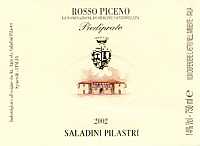
|
|
Rosso Piceno Vigna Piediprato 2002 |
|
| Saladini Pilastri (Italy) | |
| Grapes: Montepulciano (50%), Sangiovese (50%) | |
| Price: € 13,00 | Score: |
| The wine shows an intense ruby red color and nuances of ruby red, little transparency. The nose reveals intense, clean, pleasing and refined aromas that start with hints of black cherry and violet followed by aromas of blueberry, plum, licorice, tobacco, vanilla, cocoa and hints of mace. In the mouth has good correspondence to the nose, a slightly tannic attack and pleasing roundness, however balanced by alcohol, good body, intense flavors, agreeable. The finish is persistent with flavors of plum and black cherry. This wine ages in barrique for 12 months. | |
| Food Match: Roasted meat, Broiled meat and barbecue, Stewed meat, Hard cheese | |
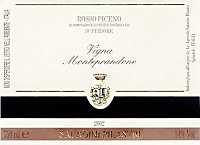
|
|
Rosso Piceno Superiore Vigna Monteprandone 2002 |
|
| Saladini Pilastri (Italy) | |
| Grapes: Montepulciano (70%), Sangiovese (30%) | |
| Price: € 20,00 | Score: |
| This wine shows an intense ruby red color and nuances of ruby red, little transparency. The nose reveals intense, clean, pleasing and refined aromas which start with hints of black cherry and plum followed by aromas of blueberry, carob, violet, tobacco, vanilla, licorice and cinnamon. In the mouth has good correspondence to the nose, a slightly tannic attack and however balanced by alcohol, good body, intense flavors, good tannins. The finish is persistent with flavors of plum, black cherry and blueberry. This wine ages for 18 months in barrique. | |
| Food Match: Braised and stewed meat with mushrooms, Roasted meat, Hard cheese | |
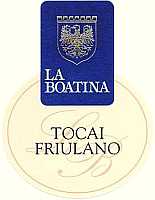
|
|
Collio Tocai Friulano 2003 |
|
| La Boatina (Italy) | |
| Grapes: Tocai Friulano | |
| Price: € 10,50 | Score: |
| This wine shows an intense greenish yellow color and nuances of greenish yellow, very transparent. The nose reveals good personality with intense, clean, pleasing, refined and elegant aromas that start with hints of pear and peach followed by aromas of hawthorn, almond, broom, pineapple, lemon, elder and hints of mineral. In the mouth has good correspondence to the nose, a crisp and pleasing attack, however well balanced by alcohol, good body, intense flavors, agreeable. The finish is persistent with flavors of peach, pineapple, pear and almond. A well made wine. | |
| Food Match: Fried fish, Eggs, Cold cuts, Pasta and risotto with crustaceans and vegetables | |
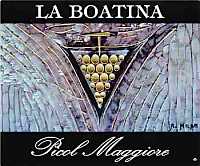
|
|
Collio Rosso Riserva Picol Maggiore 2000 |
|
| La Boatina (Italy) | |
| Grapes: Merlot (70%), Cabernet Sauvignon (20%), Cabernet Franc (5%) | |
| Price: € 15,00 | Score: |
| The wine shows an intense ruby red color and nuances of garnet red, little transparency. The nose denotes intense, clean, pleasing and refined aromas which start with hints of black cherry, plum and violet followed by aromas of carob, licorice, blueberry, vanilla and hints of mint. In the mouth has good correspondence to the nose, a slightly tannic attack and pleasing roundness, however balanced by alcohol, good body, intense flavors, good tannins, agreeable. The finish is persistent with flavors of plum and black cherry. This wine ages for 15 months in cask and followed by an aging in bottle for 15 months. | |
| Food Match: Stewed and braised meat, Roasted and broiled meat, Hard cheese | |
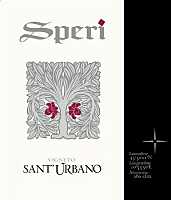
|
|
Valpolicella Classico Superiore Sant'Urbano 2001 |
|
| Speri (Italy) | |
| Grapes: Corvina (70%), Rondinella (25%), Corvinone, Molinara (5%) | |
| Price: € 13,30 | Score: |
| The wine shows an intense ruby red color and nuances of garnet red, little transparency. The nose denotes intense, clean, pleasing and refined aromas which start with hints of black cherry, blackberry and vanilla followed by aromas of blueberry, plum, dried violet, licorice, tobacco and menthol. In the mouth has good correspondence to the nose, a slightly tannic attack and however well balanced by alcohol, good body, intense flavors, good tannins. The finish is persistent with flavors of black cherry, plum and blueberry. A well made wine. This Valpolicella ages for 18 months in cask. | |
| Food Match: Roasted and broiled meat, Braised meat, Hard cheese | |
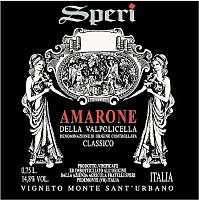
|
|
Amarone della Valpolicella Classico Vigneto Monte Sant'Urbano 2000 |
|
| Speri (Italy) | |
| Grapes: Corvina (70%), Rondinella (25%), Corvinone (5%) | |
| Price: € 39,00 | Score: |
| This Amarone shows a deep ruby red color and nuances of garnet red, little transparency. The nose reveals intense, clean, pleasing, refined and elegant aromas which start with hints of black cherry, blackberry and vanilla followed by aromas of plum jam, dried violet, licorice, tobacco, clove, cocoa, black pepper and menthol. In the mouth has good correspondence to the nose, a slightly tannic attack, pleasing roundness, however well balanced by alcohol, full body, intense flavors, good tannins. The finish is persistent with flavors of blackberry, black cherry and plum jam. A well made wine. This Amarone ages for 36 months in cask. | |
| Food Match: Game, Roasted meat, Stewed and braised meat, Hard cheese | |
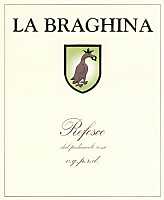
|
|
Lison Pramaggiore Refosco dal Peduncolo Rosso 2003 |
|
| La Braghina (Italy) | |
| Grapes: Refosco dal Peduncolo Rosso | |
| Price: € 9,50 | Score: |
| The wine shows a brilliant ruby red color and nuances of ruby red, moderate transparency. The nose denotes intense, clean and pleasing aromas which start with hints of black cherry and blueberry followed by aromas of raspberry, blackberry, plum and violet. In the mouth has good correspondence to the nose, a slightly tannic attack and pleasing crispness, however balanced by alcohol, good body, intense flavors, good tannins. The finish is pretty persistent with flavors of black cherry and raspberry. | |
| Food Match: Sauteed meat with mushrooms, Stuffed pasta, Broiled meat | |
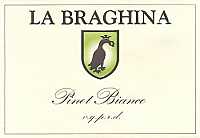
|
|
Lison Pramaggiore Pinot Bianco 2003 |
|
| La Braghina (Italy) | |
| Grapes: Pinot Blanc | |
| Price: € 8,50 | Score: |
| The wine shows a brilliant greenish yellow color and nuances of greenish yellow, very transparent. The nose denotes clean and pleasing aromas which start with hints of pear, broom and lemon followed by aromas of hawthorn, peach and litchi. In the mouth has good correspondence to the nose, a crisp attack and however balanced by alcohol, delicate, intense flavors. The finish is persistent with flavors of pear and peach. | |
| Food Match: Dairy products, Crustaceans appetizers, Pasta and risotto with vegetables | |
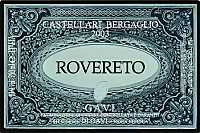
|
|
Gavi di Gavi Rovereto Vignavecchia 2003 |
|
| Castellari Bergaglio (Italy) | |
| Grapes: Cortese | |
| Price: € 9,00 | Score: |
| This wine shows an intense greenish yellow color and nuances of greenish yellow, very transparent. The nose reveals intense, clean, pleasing and refined aromas which start with hints of peach, pineapple, hawthorn and broom. In the mouth has good correspondence to the nose, a crisp attack and however balanced by alcohol, good body, intense flavors. The finish is persistent with flavors of pear, peach and pineapple. This wine ages for at least three months in bottle. | |
| Food Match: Fried fish, Pasta and risotto with vegetables and crustaceans, Dairy products, Sauteed fish | |
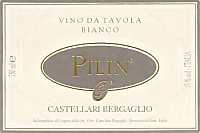
|
|
Pilin 1999 |
|
| Castellari Bergaglio (Italy) | |
| Grapes: Cortese | |
| Price: € 14,00 | Score: |
| The wine shows a pale golden yellow color and nuances of straw yellow, very transparent. The nose reveals good personality with intense, clean, pleasing and refined aromas which start with hints of ripe peach, honey and vanilla followed by aromas of pear, hawthorn, dried apricot, quince jam, broom, almond and ripe banana. In the mouth has good correspondence to the nose, a crisp attack and pleasing roundness, however balanced by alcohol, good body, intense flavors, agreeable. The finish is persistent with flavors of ripe peach, pear and honey. A well made wine. Pilin is produced with slightly dried grapes, ferments in barrique and ages for two years in bottle. | |
| Food Match: Roasted fish, Mushrooms and fish soups, Stuffed pasta, Roasted white meat | |
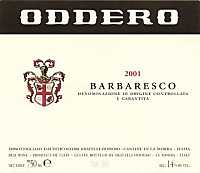
|
|
Barbaresco 2001 |
|
| Oddero (Italy) | |
| Grapes: Nebbiolo | |
| Price: € 23,00 | Score: |
| The wine shows a brilliant garnet red color and nuances of orange red, moderate transparency. The nose denotes intense, clean, pleasing and refined aromas that start with hints of violet and cherry followed by aromas of raspberry, plum, dried rose, tobacco, licorice and vanilla. In the mouth has good correspondence to the nose, a slightly tannic attack and pleasing crispness, however balanced by alcohol, good body, intense flavors. The finish is persistent with flavors of cherry, plum and raspberry. This wine ages in cask. | |
| Food Match: Roasted meat, Braised and stewed meat, Hard cheese | |
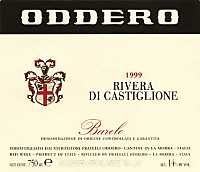
|
|
Barolo Rivera di Castiglione 1999 |
|
| Oddero (Italy) | |
| Grapes: Nebbiolo | |
| Price: € 36,00 | Score: |
| This Barolo shows a brilliant ruby red color and nuances of garnet red, moderate transparency. The nose reveals intense, clean, pleasing and refined aromas which start with hints of cherry and raspberry followed by aromas of plum, dried violet, dried rose, vanilla, licorice, cocoa and cinnamon. In the mouth has good correspondence to the nose, a slightly tannic attack and pleasing crispness, however balanced by alcohol, full body, intense flavors. The finish is persistent with flavors of cherry, raspberry and plum. This Barolo ages in cask. | |
| Food Match: Braised and stewed meat, Roasted meat, Game, Hard cheese | |
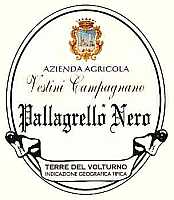
|
|
Pallagrello Nero 2002 |
|
| Vestini Campagnano (Italy) | |
| Grapes: Pallagrello Nero (Aglianico) | |
| Price: € 21,00 | Score: |
| The wine shows an intense ruby red color and nuances of ruby red, little transparency. The nose denotes intense, clean, pleasing and refined aromas which start with hints of violet and plum followed by aromas of black cherry, blackberry, blueberry, licorice, tobacco, pink pepper, cocoa and vanilla. In the mouth has good correspondence to the nose, a slightly tannic attack and pleasing crispness, however well balanced by alcohol, good body, intense flavors. The finish is persistent with flavors of plum and black cherry. A well made wine. Pallagrello Nero ages in barrique for about 15 months followed by at least 3 months of aging in bottle. | |
| Food Match: Roasted meat, Stewed and braised meat, Hard cheese | |

|
|
Casavecchia 2002 |
|
| Vestini Campagnano (Italy) | |
| Grapes: Casavecchia | |
| Price: € 21,00 | Score: |
| This wine shows a deep ruby red color and nuances of ruby red, little transparency. The nose reveals good personality with intense, clean, pleasing and refined aromas which start with hints of black cherry, raspberry and blackberry followed by aromas of blueberry, plum, violet, vanilla, licorice, carob and cinnamon. In the mouth has good correspondence to the nose, a slightly tannic attack and however well balanced by alcohol, good body, intense flavors. The finish is persistent with flavors of black cherry, raspberry and blackberry. A well made wine. Casavecchia ages for about 15 months in barrique followed by at least 3 months of aging in bottle. | |
| Food Match: Roasted meat, Braised and stewed meat, Hard cheese | |

|
|
Sannio Rosato Rosè 2003 |
|
| Torre Gaia (Italy) | |
| Grapes: Sangiovese (50%), Aglianico (50%) | |
| Price: € 4,78 | Score: |
| The wine shows an intense cherry pink color and nuances of cherry pink, transparent. The nose reveals intense, clean and pleasing aromas which start with hints of raspberry and cherry followed by aromas of cyclamen, strawberry, blueberry and plum. In the mouth has good correspondence to the nose, a crisp attack and however balanced by alcohol, good body, intense flavors, agreeable. The finish is persistent with flavors of cherry and raspberry. This wine ages in steel tanks for 6 months. | |
| Food Match: Broiled fish, Fish soups, Pasta with fish and meat, Roasted white meat | |

|
|
Sannio Rosso Aia Vecchia 2000 |
|
| Torre Gaia (Italy) | |
| Grapes: Montepulciano (50%), Aglianico (50%) | |
| Price: € 21,58 | Score: |
| This wine shows an intense ruby red color and nuances of ruby red, moderate transparency. The nose reveals intense, clean and pleasing aromas that start with hints of black cherry, violet and plum followed by aromas of blueberry, vanilla, licorice and hints of eucalyptus. In the mouth has good correspondence to the nose, a slightly tannic attack and however balanced by alcohol, good body, intense flavors. The finish is persistent with flavors of black cherry, plum and blueberry. This wine ages in cask for 18 months followed by at least 6 months of aging in bottle. | |
| Food Match: Stewed meat, Roasted meat, Broiled meat and barbecue | |

|
|
Giardini Arimei |
|
| Muratori (Italy) | |
| Grapes: Biancolella, Forastera, Uva Rilla, San Lunardo, Coglionara | |
| Price: € 21,00 - 500ml | Score: |
| This wine shows a brilliant amber yellow color and nuances of amber yellow, transparent. The nose reveals good personality with intense, clean, pleasing and elegant aromas which start with hints of dried fig, dried apricot and almond followed by aromas of peach jam, quince jam, date, honey, rhubarb, vanilla and hints of enamel. In the mouth has good correspondence to the nose, a sweet attack and however balanced by alcohol, good body, intense flavors, agreeable. The finish is persistent with flavors of rhubarb, peach jam and honey. Giardini Arimei is produced with overripe grapes and ages for 18 months in cask. | |
| Food Match: Hard cheese, Fruit tarts, Confectionery | |
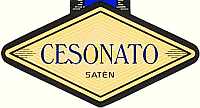
|
|
Franciacorta Satèn Villa Crespia Cesonato |
|
| Muratori (Italy) | |
| Grapes: Chardonnay | |
| Price: € 20,00 | Score: |
| This Franciacorta shows a pale golden yellow color and nuances of straw yellow, very transparent, good effervescence, fine and persistent perlage. The nose reveals intense, clean, pleasing and refined aromas which start with hints of pear, yeast and hawthorn followed by aromas of pineapple, banana, kiwi, bread crust, apple and plum. In the mouth has good correspondence to the nose, a crisp and effervescent attack, however well balanced by alcohol, good body, intense flavors, agreeable. The finish is persistent with flavors of pineapple, plum and apple. The must of this Franciacorta ferments in barrique and ages in bottle on its lees for 24 months. | |
| Food Match: Pasta and risotto with fish and crustaceans, Broiled crustaceans, Sauteed fish | |
Castello di SpessaIn a romantic castle dated back to 1200's, located on the top of a hill at the center of a park, the headquarter of the renowned winery of Gorizia dominates from the top the vineyards from which are being produced its wines |
|
When you talk about Castello di Spessa's wines it is impossible not to mention the rich and ancient history of the places in which they are produced. Located in a hill at Capriva del Friuli in the province of Gorizia - one of the most representative places of the Collio DOC area - Castello di Spessa is not only an interesting place which produces wine. Here it is also produced an excellent grappa reserve aged for many years in cask, moreover the castle is a place where every corner tells stories as ancient as Roman times. Today in the historical building is found one of the most interesting wineries of Gorizia's Collio - as well as of Friuli Venezia Giulia - and in a little more than twenty years it was capable of becoming successful in the enological scene for its excellent wines.
The origins of Castello di Spessa are lost between mystery and legend and, despite the fact there is no reliable witness, it seems it was built during Roman times and its towers were used for defensive purposes. The few documents about Castello di Spessa tell it was built at the end of 1200's and from that moment on it seems it had a pretty lively fate. The property passed to many noble families and here stayed many illustrious people of the many eras, of whom the most illustrious one was Giacomo Casanova. During the winter of 1773 Count Luigi della Torre Valvassina invited Giacomo Casanova to spend a relaxation time in his castle: a visit which is still today remembered in the long history of this place and that the winery wanted to commemorate by dedicating one of its wines to this illustrious figure. The current look of Castello di Spessa is the result of a rebuilding done in 1881 by architect Ruggero Berlam from Trieste, pupil of Camillo Boito. It was not a restoration but a proper rebuilding done according to the architectural and artistic concepts of nineteenth century. Today Castello di Spessa - besides making excellent wines - is also involved in an interesting cultural and receptive activity. The winery has dedicated to its most illustrious guest a literary prize “Giacomo Casanova Castello di Spessa” which is awarded to authors whose works are inspired by values of intellectual freedom, tolerance and cultural openness. In the “Casanova” conference hall are also held many artistic and cultural events and in the castle is also found a museum dedicated to the illustrious venetian figure of the eighteenth century. In the castle there is also a restaurant - Tavernetta del Castello - a hotel and apartments for guests who wishes to have a stay in complete freedom.
Castello di Spessa is also a place in which are being produced wines, an activity whose notoriety was also witnessed by Giacomo Casanova: «Count Torriani had vineyards with white grapes and the wine was excellent: it gave him a profit of one thousand sequins». It is the aging cellar of the twelfth century to represent the heart of Castello di Spessa, the most ancient in Gorizia's Collio. The development of viticulture was because of the work of French Count Theodore de la Tour, however the cellars, the only witness of the ancient and original structure, are dated back to the 1200's. These cellars are structured in two levels: the first and the most ancient, makes an excellent aging cellar in which are also held wine tasting events, under it, at the end of a staircase of about seventy steps and at depth of 15 meters (about 50 feet), is found the second level in a bunker built by Italians in 1930's during the war. The structure built with reinforced concrete ensures a constant temperature of 14°C (57°F) all year long and in this optimal conditions patiently age Castello di Spessa's wines. The territory of Collio is renowned for the production of excellent wines and it is right here Castello di Spessa's vineyards are found. The estate is located in hillsides near the Slovenian borders and covers a surface of 30 hectares (73 acres). Here vines benefit from a soil made of marl and sandstone of eocene origin, a favorable climate thanks to the shielding offered by Giulie Prealps to the north as well as to the influence of Adriatic sea which mitigates thermal excursions. At Castello di Spessa every wine is the result of a passionate and constant research on quality. This process begins in the vineyard, to which is payed particular care and attention, proceeds with harvest, strictly done by hand by scrupulously selecting grapes. Grapes are then processed: a soft pressing at a controlled temperature in order to ensure an optimal composition of aromas, structure and balance, with the clear goal of making wines capable of remarkable longevity. A scrupulous selection of grapes and care for production details, give origin to Castello di Spessa's crus, the reds Conte di Spessa, Casanova and Torriani aged in Allier, Tronçais and Nevers barriques in the undergrounds of the castle; whites Di Santarosa and Segrè obtained by cold maceration in order to extract the delicate and elegant aromas from skins which will give wines elegance. The range of Castello di Spessa's wines certainly are convincing: a very good quality which can be found in every wine therefore confirming the production efforts and the seriousness of this Gorizia's winery. Even base wines - all being produced with white berried grapes - are convincing, as well as “cru” wines: elegant and refined aromas with a fresh and pleasing taste. The range of Castello di Spessa's products is completed by the wonderful “Grappa Riserva del Conte 1987”, distilled in discontinuous alembic still made of copper and steam operated, aged for 15 years in the barriques used for the aging of Pinot Blanc di Santarosa.
|
||||||||||||||||||||
|
Score legend Prices are to be considered as indicative. Prices may vary according to the country or the shop where wines are bought |
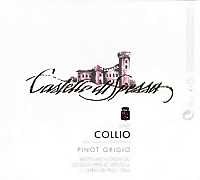
|
|
Collio Pinot Grigio 2003 |
|
| Castello di Spessa (Italy) | |
| Grapes: Pinot Gris | |
| Price: € 14,50 | Score: |
| This wine shows a pale golden yellow color and nuances of straw yellow, very transparent. The nose reveals intense, clean, pleasing and refined aromas which start with hints of hawthorn, apple and plum followed by aromas of pineapple, acacia, broom, grapefruit and pear. In the mouth has good correspondence to the nose, a crisp attack and pleasing roundness, however balanced by alcohol, good body, intense flavors, agreeable. The finish is persistent with flavors of plum and apple. This wine ages in steel tanks. | |
| Food Match: Broiled fish, Mushroom soups, Stuffed pasta with vegetables, Risotto with crustaceans | |
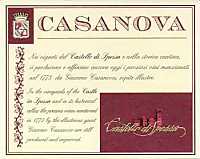
|
|
Collio Pinot Nero Casanova 2001 |
|
| Castello di Spessa (Italy) | |
| Grapes: Pinot Noir | |
| Price: € 21,00 | Score: |
| This wine shows a brilliant ruby red color and nuances of garnet red, moderate transparency. The nose reveals intense, clean, pleasing and refined aromas which start with hints of toasted wood, cherry and strawberry followed by aromas of cyclamen, raspberry, vanilla, pink pepper, licorice, cocoa and menthol. In the mouth has good correspondence to the nose, a slightly tannic attack, good crispness and pleasing roundness, however balanced by alcohol, good body, intense flavors, agreeable. The finish is persistent with flavors of cherry, raspberry and strawberry. This Pinot Noir ages in barrique for 24 months. | |
| Food Match: Roasted meat, Sauteed meat with mushrooms, Stuffed pasta | |
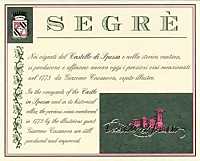
|
|
Collio Sauvignon Segrè 2003 |
|
| Castello di Spessa (Italy) | |
| Grapes: Sauvignon Blanc | |
| Price: € 20,00 | Score: |
| This wine shows a brilliant greenish yellow color and nuances of greenish yellow, very transparent. The nose reveals intense, clean, pleasing, refined and elegant aromas which start with hints of peach, box, pineapple and banana followed by aromas of broom, lemon, apple, litchi, bell pepper, pear, grapefruit and elder. In the mouth has good correspondence to the nose, a crisp attack and however balanced by alcohol, good body, intense flavors, agreeable. The finish is persistent with flavors of peach, pear and pineapple. A well made wine. This Sauvignon Blanc ages in steel tanks. | |
| Food Match: Vegetables and mushroom soups, Pasta and risotto with crustaceans, Roasted fish | |

|
|
Collio Pinot Bianco di Santarosa 2001 |
|
| Castello di Spessa (Italy) | |
| Grapes: Pinot Blanc | |
| Price: € 18,50 | Score: |
| This wine shows a pale golden yellow color and nuances of straw yellow, very transparent. The nose reveals intense, clean, pleasing and refined aromas which start with hints of banana, plum and toasted wood followed by aromas of pineapple, apple, hazelnut, pear, grapefruit, hawthorn and hints of lavender. In the mouth has good correspondence to the nose, a crisp attack and however well balanced by alcohol, good body, intense flavors, agreeable. The finish is persistent with flavors of plum, pear, banana and hazelnut. A well made wine. This Pinot Blanc ages for 9-12 months in barrique. | |
| Food Match: Roasted fish, Fish soups, Roasted white meat, Stewed fish with mushrooms | |
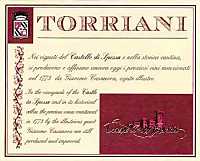
|
|
Collio Merlot Torriani 2001 |
|
| Castello di Spessa (Italy) | |
| Grapes: Merlot | |
| Price: € 20,00 | Score: |
| This wine shows an intense ruby red color and nuances of ruby red, little transparency. The nose reveals intense, clean, pleasing, refined and elegant aromas which start with hints of plum, dried violet and vanilla followed by good aromas of black cherry, black currant, blueberry, tobacco, licorice and hints of eucalyptus and cinnamon. In the mouth has good correspondence to the nose, a slightly tannic attack and however well balanced by alcohol, full body, intense flavors, good tannins, agreeable. The finish is persistent with flavors of black cherry, plum and blueberry. A well made wine. Torriani ages for 18 months in barrique. | |
| Food Match: Game, Roasted meat, Braised and stewed meat, Hard cheese | |
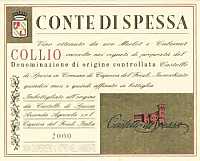
|
|
Collio Rosso Conte di Spessa 2000 |
|
| Castello di Spessa (Italy) | |
| Grapes: Merlot (75%), Cabernet Sauvignon (20%), Cabernet Franc (5%) | |
| Price: € 23,00 | Score: |
| The wine shows a deep ruby red color and nuances of garnet red, little transparency. The nose reveals intense, clean, pleasing and refined aromas which start with hints of black cherry, vanilla and plum followed by aromas of blueberry, dried violet, licorice, tobacco, cocoa, blackberry and menthol. In the mouth has good correspondence to the nose, a slightly tannic attack and pleasing roundness, however well balanced by alcohol, full body, intense flavors, good tannins. The finish is persistent with flavors of plum, black cherry and blackberry. A well made wine. Rosso Conte di Spessa ages for 24 months in barrique. | |
| Food Match: Game, Roasted meat, Braised and stewed meat, Hard cheese | |
| Castello di Spessa - Via Spessa, 1 - 34070 Capriva del Friuli, Gorizia - Italy - Tel. +39 481 639914 Fax. +39 481 630161 - Winemaker: Domenico Lovat with the help of Gianni Menotti - Established: 1981 - Production: 100.000 bottles - E-Mail: info@castellospessa.com - WEB: www.castellospessa.com |
Cellar Journal |
|
This section is reserved to wine producers who want to publish news and information about their business, to announce new products or just for communicating to its customers information and promotions about their products and activity. Send news to be published at our e-mail address.
|
News |
|
In this section will be published news and information about events concerning the world of wine and food. Whoever is interested in publishing this kind of information can send us a mail at our address.
|
Production of Rose WineOften forgotten by consumers and considered as wines having no identity, rose wines are produced with specific techniques and have interesting qualities |
|
In case we have to tell an underrated and scarcely considered category of wines in the wine world, it would be the one of rose wines. These wines are usually not very considered by consumers and by wine people, as well as being victims of unjust prejudices with the result of losing their dignity and identity as a wine. The ones responsible for this condition are both consumers - who usually consider these wines neither whites nor reds, therefore not wines - and professional figures who work on wine business who usually forget about them or have no interest in selling them. One of the worst prejudices about rose wines and responsible for their bad reputation, is the conviction they are produced by blending white and red wines together. To tell the truth this conviction is the result of a deprecable habit of restaurateurs and producers who in the past, with no scruple - as well as with no intelligence - were used to blend whites and reds in order to create a terrible pink colored wine. We believe we should make things clear about this prejudice: the production of rose wines obtained by blending white and red wines is forbidden by law in all wine countries of the world. The only rose wines that can be made this way are the base wines used for the production of classic method sparkling wines, such as Champagne and Franciacorta. Rose wines are created by means of specific techniques and with the goal of producing a pink colored wine and therefore they should not be considered as lesser wines or wines that cannot be classified. The production of this type of wines is witnessed by the traditions of many wine areas in the world, where rose wine has always had its own dignity and its own meaning, such as French Provence, Apulia - renowned are roses from Salento - and Abruzzo with its Montepulciano d'Abruzzo Cerasuolo. Moreover it should be remembered rose classic method sparkling wines are highly appreciated among wine connoisseurs. If among sparkling wines roses are well accepted and appreciated, why should not it be the same for table wines? The scarce information certainly played a fundamental role in their low spreading and acceptance.
Nevertheless rose wines can offer a high versatility even in the table and allow extremely balanced and interesting enogastronomical matchings. Sometimes in matching a wine with a food, when a white wine is not enough and a red wine is simply too much, the answer is most of the times offered by rose wines. In this sense rose wines occupy a proper and definable position in the wine scene, a position which cannot be occupied neither by whites nor by reds, and therefore they have their own identity. It would be good that everyone would be capable of broadening the cognition of table wines and considering the possibilities among whites, roses and reds, not just between whites and reds. Rose wines represent a world of its own in every sense, from the way they are being produced to their organoleptic qualities. The production of rose wines begins as for red wines and continues as for white wines, a result which is expressed every time they are being poured in a glass: the color reminds red wines although they are being served as white wines.
|
||||||||
|
Rose wines, despite the fact they are not very common and appreciated, can be produced with different wine making techniques, each one giving results with distinct qualities, therefore the generic category of rose wines includes a group of wines produced with different techniques. All rose wines have a characteristic in common: they all are produced with red berried grapes. The only exception is represented by rose sparkling wines which are produced most of the cases - and only exception in enology - by blending white wines and red wines in variable quantities in order to obtain a rose wine. No matter this is the most common method for the production of rose sparkling wines, it should be remembered excellent results can be obtained by exclusively using red berried grapes, a techniques still used by few producers of rose Champagne with Pinot Noir and Pinot Meunier grapes. In theory any red berried grape can be used for the production of rose wines, however there are varieties which are more appropriate than others. The production of rose wines can be described - in general terms - as a process which begins as in red wines and continues as in white wines. The main difference between the production of white wines and red wines - and however not the only one - is that in reds the must is allowed to macerate in skins in order to extract color, whereas in whites this procedure is avoided. Grape's skin is rich in aromatic substances and in case of red berried grapes, it is also rich in colorant substances. The maceration of must in skins has also the purpose of extracting aromas - and color, in case of red grapes - which will enrich grape juice before proceeding with fermentation. The maceration also allows the extraction of other polyphenolic substances, commonly called tannins, responsible for astringency and body in wine. Rose wines have a different structure from red wines, are less astringent, have the crispness of white wines and an “intermediate” color between whites and reds. Color in rose wines - just like in red wines - is obtained by macerating the must in skins for a variable time from few hours to about two days. The time of maceration depends on the wine to be produced and to the coloring capacity of grapes. At the end of maceration, must is separated from skins and therefore the process continues as for white wines. The maceration of the must in skins is done in different ways each of them giving specific results. Rose wines are classified according to the production method and precisely: vin gris (grey wines), blush wines, wines of one night, wines of one day and saignée. Vin gris are not grey colored wines - as the name could suggest - but are wines with a very pale rose color. Grey wines are produced by using the same enological procedures as for white wines in which the only difference is represented by the usage of grapes having a very low colorant capacity, such as Cinsaut Rose, Cinsaut Gris and Cinsaut. This type of wine is produced by pressing the grape while avoiding the maceration of the must in skins, just like for white wines. This technique is used in some French areas by using Gamay grape in case it does not reach optimal ripeness in order to make a red wine. A similar technique is used in the United States of America for the production of the so called blush wines. Blush wines have become famous in the United States thanks to the White Zinfandel fashion, produced with Zinfandel grape, which is a red grape, by using the common wine making techniques used for white wines. After the success of White Zinfandel, other blush wines appeared in the market which were made of other varieties, of which the most famous ones are White Grenache, Cabernet Blanc, Merlot Blanc and Blanc de Pinot Noir. Blush wines usually have a demi-sec taste and are generally characterized by a slightly effervescence. It should also be remembered in California some wineries produce dry blush wines aged in cask and that are known as vin gris. Rose wines with more intense colors, almost tending to red, are produced by macerating the must in skins for variable times from few hours to some days. The duration of maceration essentially depends on the coloring capacity of grapes and on the type of rose wine to be made. In this way are produced the so called wines of one night and wines of one day. In case the maceration lasts for 6-12 hours, the rose wine is called wine of one night, whereas with a duration of about 24 hours it is called wine of one day. During the maceration it is essential to avoid fermentation, therefore sulfites are added to the must and the temperature kept low. At the end of maceration the must is being fermented and the vinification process continues as for white wines. A technique used for the production of rose wines is the so called saignée, commonly known as bleeding. This technique is generally used by wineries which produce red wines and by some Rose Champagne producers. The bleeding technique consists in drawing a certain quantity of must from the maceration tank in which it is being produced a red wine. The part of must drawn from the tank is vinified by using white wine procedures and therefore the result will be a rose wine. The remaining part of must continues its maceration and will used for the production of a red wine. In red wine production this technique is used to increase the proportion of aromatic and phenolic substances in the must with the result of obtaining a more concentrated and structured red wine.
|
||||
|
After having prepared the base must by using one of the method discussed above, the vinification process continues by following the common procedures used in white wines. Rose wines are generally fermented in inert containers, such as steel and concrete, rarely in wood containers, such as casks and barriques. The same considerations are valid for the aging and are pretty rare producers who decide to age their rose wines in cask for some months. Rose wines are generally ready within the springtime following harvest and it is best to drink them during their youth. At the end of the fermentation process and of aging, rose wines are stabilized and filtered, just like any other white wine, and therefore bottled and commercialized. Because of their low contents in polyphenols, as well as for their tendency to rapidly lose acidity, rose wines are not very suited for the aging in bottle and it is best to drink them within two years from harvest. With time rose wines tend to lose their best qualities in aromas and taste, as well as their pleasing aromas of fruits and flowers, therefore they are wines which should be consumed as soon as possible. This characteristic, which is also shared with most of the white wines, represents one of the factors considered as negative by consumers. Paradoxically the same happens for white wines - which in turn are more esteemed and have a higher reputation - and, just like for rose wines, offer in most of the cases their best qualities of freshness and agreeability during their youth.
|
BeerAmong the most common beverages of the world, the history of beer is as ancient as the history of humanity and today it is widely appreciated and consumed in every country |
|
The tradition of making beer is found in almost every country in which grains are being cultivated. This beverage is widely common and appreciated in many areas of the world as well as by many social classes.
|
|
The origin of beer is, just like most of traditional beverages, uncertain, however known historical sources proved its first production in Egypt, Mesopotamia and Malta. The practice of fermentation was accidentally discovered at the same time in many areas of the world. Human beings, at the beginning of their history, survived thanks to the fruits of land and hunting, in later times they developed the ability of agriculture and in particular the cultivation of grains. The first documents about beer are from Sumerian people and are dated back five thousands years ago. A very ancient tablet - whose origins are from the Assyrian area, in the area between the Tigris and Euphrates rivers - in which are written information about the brewer's job. At those times the beer was not consumed for pleasure only and it was probably considered as a ritual beverage, in fact it was drunk in occasion of religious events as well as being part of the funerary ceremony and offered to gods by Assyrian-Babylonians. In the land of pharaohs “henquet”, that is beer, was so common that Egyptians were used to drink even during childhood, aromatized with lupines, and considered both as a food and as a remedy. It seems Egyptians consumed beer since their childhood and the beverage was diluted with water and honey and given to babies for it was considered as a supportive food to motherly milk. Celts, in the Britannic islands, in particular in the Irish area, played an important role in the tradition of brewing. The legend about the origins of Irish people is strongly connected to the “secret” of brewing. Even in Greece beer was very appreciated: during the period of celebrations dedicated to Demeter goddess, beer “flowed like rivers”. In Italy were Etruscans to introduce the tradition of brewing and they subsequently influenced Romans. In the Middle Age the technique of brewing was developed and passed to monasteries where monks tried to refine and improve the production technique. Until then beer was aromatized with herbs and spices and monks were successful in dramatically improving the production technique by introducing hop. From hop it is being obtained a yellowish liquid having antiseptic, aromatic and preservative qualities which makes beer more aromatic and limpid.
In England beer became more and more popular and it was then considered as the national beverage, it was brewed both in monasteries and by housewives in occasion of religious events. Popular wisdom taught the use of boiled water for the preparation of the beverage therefore making beer hygienically safe because water was not always drinkable. In 1516, in Bavaria, were promulgated the first laws about beer: in Reinheitsgebot was promulgated the so called “edict about purity”. From that moment on beer began to be produced according to specific laws: it could only be made of barley malt, hop and water, nothing else. In subsequent years the evolution of the art of brewing continued its slow but inexorable evolution by developing new fermentation techniques and the choice of the more appropriate yeasts. Today beer is mainly produced by industries, however there are also many small and traditional breweries involved in researching ancient and traditional recipes in order to offer their customers flavors and traditions of ancient times.
|
||||||||
|
Despite the main ingredients are water, yeast, barley and hop, tradition, taste, culture, availability and quality of raw matters as well as production techniques, gave origin to countless styles of beer. This beverage can be produced with wheat, rye, corn, rice and other grains, however barley is the most common cereal. For master brewers not all the barley is good for the making of beer and particular attention is paid during its choice. The other important ingredient is water which is carefully chosen and prepared as mineral salts, alkalinity, microorganisms and bacteria, influence all the production phases. Some producers prefer to demineralize water and to add specific mineral salts that, according to their opinion, are best suited for the production of beer. Hop is responsible for the aromatization of beer, therefore it must be chosen with particular care by expert personnel. Tannins, oils and bitter acids are evaluated in order to give aromas and foam to the finished product. The most famous areas for the production of quality hop are Czechoslovakia (Saanz), Belgium (Poporinge), England (Kent) and Germany (Hallertau and Tettnang). Even yeast plays a fundamental role as it is responsible for the conversion of sugar into alcohol. The main species of yeast currently used for the production of beer are “Saccharomyces Cerevisiae” and “Saccharomyces Carlsbergensis”. The former is used for high fermentation beers whereas the latter for low fermentation beers. According to a primary classification, beer is divided into:
The main types of beer are:
|
|
Beer is among the most common beverages and it is practically found in every country of the world. Among the many countries, each one having its brewing traditions, are mentioned the following:
|
|
Just like wine, beer has its rules in order to be tasted to its best. The glass must be clean and with no smells, it is good to avoid perfumed soaps, in this case it is recommended to carefully rinse the glass. One of the purpose of the glass is to protect beer from the contact with air, to emphasize color, perlage and foam. There are many types of beer glasses each one having its characteristics and suited for a specific type - such as the beer glass and balloon - or glasses associated to tradition, such as stiefel. When the beer is being poured it is advised to use a wet glass held in an oblique position. Low fermentation beer - characterized by a more delicate aroma - are served cool in a tall and narrow glass. High fermentation beers require a glass having the upper border slightly flared. A balloon will be good for full bodied meditation beers, whereas a glass with a narrowing opening will be appropriate for a Lager or Pilsener. An aromatic beer will prefer a tulip glass, whereas a conic column glass will enhance the aromas of Danish beers. Pint is the ideal glass for Stout, whereas mass and tankard are considered as universal glasses. Before pouring the beer it is advised to make sure the glass is properly cooled down in order to avoid beer a thermal shock. As for keeping, beer likes dim lights, a constant temperature from 18 and 20° C (64-68° F) and a dry room. Another characteristic to be considered is that beer is a beverage to be consumed fresh - with the exception of some styles which can be aged - therefore it is suggested to carefully read the label. Enjoy your beer!
|
||||
AquavitaeReview of Grappa, Distillates and Brandy |
|
|
| Distillates are rated according to DiWineTaste's evaluation method. Please see score legend in the "Wines of the Month" section. |

|
|
Grappa di Amarone della Valpolicella |
|
| Sartori (Italy) | |
| (Distiller: Distilleria Scaramellini) | |
| Raw matter: Pomace of Molinara, Corvina, Rondinella | |
| Price: € 23,00 - 500ml | Score: |
| The aspect of this grappa is colorless, limpid and crystalline. The nose denotes intense, clean and pleasing aromas of plum, blackberry, dried violet, licorice and walnut with almost imperceptible alcohol pungency. The taste is intense, pretty good roundness and very balanced sweetness, the alcohol, non aggressive which rapidly dissolves. The finish is intense and persistent with pleasing sweet hint and good flavors of plum and licorice. This grappa is made with the discontinuous method with submerged pomace in copper still alembics. Alcohol 40%. | |

|
|
Grappa di Teroldego |
|
| Bertagnolli (Italy) | |
| Raw matter: Pomace of Teroldego | |
| Price: € 14,00 - 70cl | Score: |
| This grappa in colorless, limpid and crystalline. The nose is intense with pleasing and refined aromas of violet, pear, raspberry, cherry, plum and blackberry and imperceptible alcohol pungency, very pleasing. The taste is intense and smooth with very balanced sweetness, the alcohol is perceptible and however not aggressive and dissolves rapidly, agreeable. The finish is intense and persistent with pleasing sweet hint and good flavors of plum, cherry and raspberry. A well made grappa produced with discontinuous method in steam operated alembic stills. Alcohol 42%. | |

|
|
Grappa Koralis |
|
| Bertagnolli (Italy) | |
| Raw matter: Pomace of Teroldego, Chardonnay, Traminer | |
| Price: € 12,50 - 70cl | Score: |
| This grappa shows a brilliant amber yellow color, limpid and crystalline. The nose reveals intense, clean, pleasing and refined aromas of vanilla, dried plum, licorice, hazelnut, raspberry and ripe banana with imperceptible alcohol pungency, elegant. The taste is intense and smooth, very agreeable with very balanced sweetness, the alcohol is perceptible although not aggressive which rapidly dissolves. The finish is intense and persistent with pleasing sweet and round hint and good flavors of vanilla, dried plum and licorice. A well made grappa produced with discontinuous method in steam operated alembic stills and aged in Limousine, Tronçais e Allier barriques for at least 9 months. Alcohol 42%. | |

|
|
Gioiello Nonino Distillato di Miele di Castagno |
|
| Nonino (Italy) | |
| Raw matter: Chestnut honey | |
| Price: € 25,00 - 350ml | Score: |
| This distillate is colorless, limpid and crystalline. The nose reveals personality with intense, clean, pleasing, refined and elegant aromas of chestnut honey, honeybee and white rose with imperceptible alcohol pungency. A wonderful bouquet of extraordinary, refined and elegant femininity. The taste is intense, smooth, very agreeable, very balanced sweetness, with very low alcohol pungency which dissolves rapidly, very elegant. The finish is very persistent with a rich and pleasing flavor of chestnut honey and elegant sweet hint. A wonderful distillate produced with the discontinuous method in steam operated alembic stills. Alcohol 37%. | |
Wine Parade |
|
|
| The best 15 wines according to DiWineTaste's readers. To express your best three wines send us an E-mail or fill in the form available at our WEB site. |
| Rank | Wine, Producer | |
|---|---|---|
| 1 |
| Turriga 1998, Argiolas (Italy) |
| 2 |
| Amarone della Valpolicella Classico Capitel Monte Olmi 1999, Tedeschi (Italy) |
| 3 |
| Montepulciano d'Abruzzo Villa Gemma 1999, Masciarelli (Italy) |
| 4 |
| Brunello di Montalcino Prime Donne 1998, Donatella Cinelli Colombini (Italy) |
| 5 |
| Barolo Cicala 1999, Poderi Aldo Conterno (Italy) |
| 6 |
| Harmonium 2001, Firriato (Italy) |
| 7 |
| Riesling Cuvée Frédéric Emile 1999, Maison Trimbach (France) |
| 8 |
| Aglianico del Vulture La Firma 2000, Cantine del Notaio (Italy) |
| 9 |
| Pinot Noir Napa 2002, Clos du Val (USA) |
| 10 |
| Rioja Reserva Era Costana 1999, Bodegas Ondarre (Spain) |
| 11 |
| Chablis Grand Cru Les Clos 2002, Domaine Billaud-Simon (France) |
| 12 |
| Uncut Shiraz 2002, Gemtree Vineyards (Australia) |
| 13 |
| Jerez Fino Tio Pepe, Gonzalez Byass (Spain) |
| 14 |
| Moscato d'Asti 2003, Vignaioli di S. Stefano (Italy) |
| 15 |
| Château Roquebrun St-Chinian 2002, Cave de Roquebrun (France) |
| |||||||
Privacy Policy | |||||||


| Copyright © 2002-2024 Antonello Biancalana, DiWineTaste - All rights reserved |
| All rights reserved under international copyright conventions. No part of this publication and of this WEB site may be
reproduced or utilized in any form or by any means, electronic or mechanical, without permission in writing from DiWineTaste. |